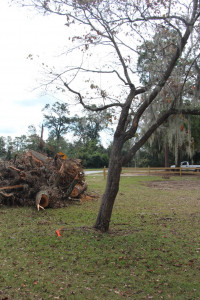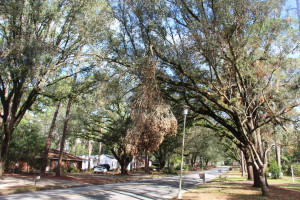With all the recent severe weather activity throughout the Southeast, it’s important to assess how your trees weathered the storms. Often a home or business owner’s focus is on cleaning up vegetative debris on the ground, but it is prudent to look up and monitor the structural condition of your trees after any storm event. Trees are put under a tremendous amount of force and pressure during periods of high winds, and sometimes damage can occur that jeopardizes the health or structural integrity of a tree. But don’t be alarmed; storm damage can often be mitigated or minimized through regular assessment and proper treatment.
The more obvious and visible forms of storm damage can present as hanging branches, both detached and partially attached. Other storm damage signs that can be noticed during a basic visual assessment include cracks along branches or stems, excessive loss of leaves and canopy tissue, or compromised root plates. All of these tree injuries could become larger issues down the road if not addressed. You can send pictures of storm damage to GFC’s “Ask the Arborist” at https://gatrees.org/urban-community-forestry/ask-the-arborist/ for input and information about your storm damage mitigation options.
It is imperative that all formal tree assessments and treatment be conducted by an International Society of Arboriculture (ISA) Certified Arborist. A directory of ISA Certified Arborists in Georgia can be found at https://www.treesaregood.org/findanarborist.
Trees play a huge role in our communities on environmental, social, and financial levels. Typically they can handle storm events with no problems. But when storms do cause tree damage, it’s up to us to make sure they get the proper treatment they need in order to keep providing the many benefits they give us every day. Continue to appreciate your trees on a clear day, but remember to keep an eye on them after storms and lend them a hand when you can!



